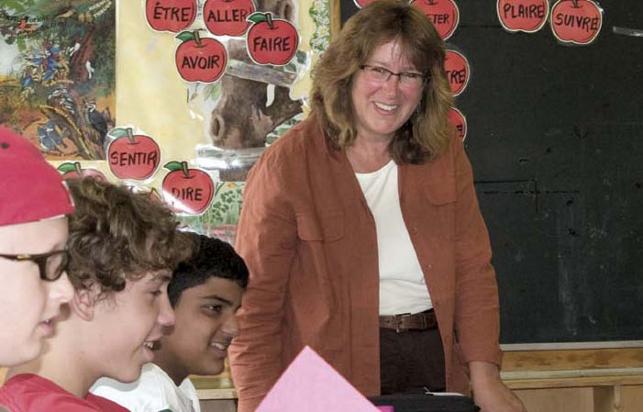
French's Sad Lament
Imagine the scene as Madame Bonprof goes through her day: the gas tank in her car is full in anticipation of the drive to the two schools where she teaches core French; her plastic milk crate contains all of her materials – flashcards, CD player, CDs, a set of textbooks enough for half the class, and students’ notebooks, each grade indicate by colour.
The entry bell rings, and she starts class in Room 1, at the end of the main hall. But wait, the red file of flashcards for this class is missing – she probably left it in the car when she reorganized her supplies. Madame looks for space on the chalkboard to illustrate vocabulary but notes and chart paper cover the walls, and there is no room to demonstrate the lesson.
The bell to end class finally rings, and Madame proceeds to climb the stairs, milk crate in hand, to get to Room 26, at the other end of the school. The principal stops her along the way to confer about a parent issue, and she arrives five minutes late, reducing her colleague’s preparation time. This grade 7 class runs a little more smoothly, although she has to deal with two ESL students who have just registered. Class over, Madame now heads to her other school, but a train crossing puts her behind schedule, and she again arrives late, this time for outdoor duty. At least tomorrow is a PD day. Then it occurs to her: the morning agenda calls for a session on using manipulatives in math, and the afternoon will focus on team planning. Where does core French fit?
The challenges of FSL
Recent studies and surveys have verified the discouraging state of FSL teaching and learning.1 Unfavourable conditions for FSL (especially core French) relative to other “core” subjects reflect its diminished status. Teachers and students are expected to make the situation work, and to achieve high standards that require considerable resources and support, even when these are in short supply.
The issues are many: itinerant assignments (between classrooms and schools); lack of designated classrooms; limited support for IEP and ESL students; scarce resources; requirements to provide preparation time and supervision duties; isolation in school and board communities. Added to the list: expectations to integrate technology despite insufficient software and computer access; few professional development opportunities (for the most part sessions are offered only after school); and a lack of an autonomous budget and funding. Is it any wonder that almost 40 percent of respondents to a survey done by the Canadian Association of Second Language Teachers (CASLT) have considered leaving FSL teaching, at one time or another?2
FSL is not a ministry priority
Support at the ministry level is also lacking: currently, there is one FSL portfolio at the Ministry of Education for the entire province. The result is missed opportunities and insufficient curriculum support. The message from the ministry appears to be that the FSL curriculum (the chief vehicle for teaching and learning our other official national language) and the related classroom environment are less important than other programs.
For example, Ontario teachers and students have missed out on interprovincial programs such as the Summer Language Bursary Plan because there are not enough ministry staff to handle the administrative duties. There is little curriculum support for French immersion classrooms. Immersion teachers must individually adapt curriculum support materials intended for English-language or francophone schools. Neither is appropriate for the immersion classroom, and because teachers translate in isolation there is a great deal of duplication of effort.
Tracking provincial funding for FSL is also problematic. Although information is available about the FSL allocations for each school board, it is not possible to determine how these funds are actually spent, or whether they actually reach the FSL classroom.
Accessing federal funds
Ontario has also been slow to avail itself of federal funding. Although the federal government announced Action Plan 2013 for improved French-language education in 20043, it was only in the spring of 2006 that Ontario school boards were invited to submit project proposals (on extremely short deadlines) to fulfill the mandate of the action plan – that is, to double the percentage of bilingual students graduating from high school by 2013.
A variety of initiatives have been (and will be) implemented with limited chance for success. These innovative and exciting endeavours will be carried out in the context of the everyday FSL teacher’s experience – no designated classroom, no support for challenging students, and continued demands to cover preparation time and supervision duties. Again, FSL teachers (especially core French teachers) will be expected to make the action plan work and to achieve the results anticipated by the mandate of the grants.
FSL teachers can have an impact
As professionals with an important national and social mandate (to provide quality official language education to our citizens and immigrants), individual French teachers also have an important role to play. Yes, professional development sessions are offered for the most part after school, but if French teachers don’t show up, the message will be that we aren’t interested. Yes, we have no designated classrooms, yet if administration doesn’t hear about the deficiencies of this arrangement, they will assume that we are satisfied with the situation. Yes, we all have challenging students, yet their success in French is as important as their success in any other curriculum area. Teachers must be determined in seeking support for students with special needs. And yes, none of this is just – why do we have to spend so much time and energy advocating for ourselves and for our students?
ETFO’s FSL Standing Committee is working hard to improve the prospects for our members who teach French. We have met with members of other groups interested in improving FSL education in Canada and hope that ETFO will become part of a strong FSL network in the province, intent on improving the learning and teaching conditions for everyone.
We all are responsible for raising the marginal status of FSL, and for suggesting solutions and alternatives. With the consistent support of ETFO (ask your local to establish an FSL committee to help raise the profile of our issues), we can make changes. It is time to organize and consolidate our efforts to achieve quality teaching and learning conditions: our teachers and our students deserve better!
Notes
1 A. Mollica, G. Phillips, & M. Smith (2006), “Teaching and Learning French as a Second Language: Core French in the Elementary Schools of Ontario,” Ontario Modern Language Teachers’ Association and Brock University; S. Kissau (2005), “The Depreciated Status of FSL Instruction in Canada,” Canadian Journal of Educational Administration and Policy, no. 44; Canadian Parents for French (2006), The State of FSL Education in Canada 2006 Report; CASLT (2006), First National French as aSecond Language Teacher Survey; ETFO FSL StandingCommittee (2006), Survey of Local Presidents Regarding FSL.
2 CASLT Teacher Survey.
3 Kissau (2005)

